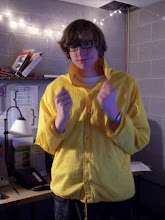Either way, I raked: Five books. Eleven dollars. Including:
-Roddy Doyle, A Star Called Henry
-Joseph Mitchell, Up In The Old Hotel (read the back of the book and it looks like a pretty badass collection of nonfiction journalism)
-Jonothan Franzen, The Corrections (hardback)
-David Halberstam, The Best American Sportswriting of the Century
The real gem, though, is this book called Oh, How They Played the Game!: The Early Days of Football and the Heroes Who Made it Great (hardcover, three dollars). I looked for a link on Amazon and it's out of print. I think it's from the 70s, or thereabouts, and basically consists of a bunch of old-time newspaper and magazine articles about football from the 1870s to the 1930s, all compiled by this crotchety old former New York Times sportswriter.
As you'd expect, it's nothing short of awesome. Among accounts of the first Princeton-Rutgers game and the whole Grantland Rice "Four Horsemen" article (neat, but obvious and everywhere), it has a bunch of random, interesting pieces on all sorts of things, from the first Army-Navy game to a bunch of old pieces on the U of M football team from the Michigan Daily.
The best of these, so far, is an article from Colliers from 1931, written by Pop Warner about his days coaching for the Carlisle Indian School, which closed in something like 1918 but had sweet teams in the late 1890s. The star player on this team was Jim fuckin' Thorpe.
It has some interesting views on race, seeing as how all of the players were Native Americans. I guess Carlisle was one of those evil Indian boarding schools which attempted to "de-savege" Native Americans...which sucks. But Warner has some insight:
Like [the University of] Chicago, Carlisle had no traditions, but what the Indians did have was a real race pride and a fierce determination to show the palefaces what they could do when the odds were even. It was not that they felt any definite bitterment against the conquering white or against the government for unfair treatment, but contests between red men and white men had never been waged on even terms.And so on. I somehow never realized that Jim Thorpe went to an Indian school like that, nor that they were a powerhouse for about four years in college football. Warner's entire article (about 10 and a half pages in the book) is a pretty in-depth retelling of his time there. At the end he says that the white players he coached were whiny bitches a lot of the time (I'm paraphrasing there, if you couldn't tell), but the players at Carlisle were some of the best men he had ever coached on or off the field.
'You outnumbered us, and you also had press agents,' a young Sioux once said to me. 'When the white men won it was always a battle. When we won, it was a massacre.'
Basically, this book is an essential for anyone interested in college football. And sports. And sports writing. Too bad the damn thing's out of print.
*Also, three albums bought tonight: new Super Furry Animals, new Thermals and old Les Savy Fav. Quickly, on each:
-SFA was vinyl only with a free HQ mp3 download. Why every record label doesn't just do this for every album is beyond me. It really is more of a rock record than Hey Venus. On first listen, I'm not sure it's technically "better," but Venus was way too short. It had 11 songs, but they were all under five minutes. This one has 12, but the songs are a bit longer and more meandering so it doesn't feel like they short-changed you on content. For that reason alone, I think it gets enough points to boost it above Venus.
-Les Savy Fav has weird songs and awesome track names. If you can find their performance on Conan you'll wonder who booked them, because they are NOT made for TV (not necessarily filthy, but bizarre as hell, on record and onstage).
-Thermals production values are high. So much so that it doesn't even sound like them. Compare this (from their first album) to this (from Now We Can See). I used to think that their lo-fi nature was the main reason why I liked them, but....damn, do they write some catchy guitar hooks. And choruses. (Although nothing on this album touches the hook on Pillar of Salt. Nothing.)
